Description
The palace, whose designer is unknown, differs from the buildings on Strada Nuova. The lower part of the façade is decorated with diamond-pointed ashlar, while the upper floors were originally relieved by a series of open loggias, later closed by glazing and walled up in the early Ocento, as can be seen from Rubens' engravings in the 1652 edition of Palazzi di Genova. [2]
Also on the façade is the portal supported by two telamons with mozzi noses, the work of Taddeo Carlone, who here evokes the atrocious legend of Megollo Lercari, ancestor of the commissioner, took revenge on his enemies by mutilating their noses and ears. [3]
First floor
Going up to the first of the two piani nobili, in the loggia, within two nicchie, there are the busts of Franco Lercari and his wife Antonia De Marini by Taddeo Carlone, the Emperor Charles V of Habsburg and the King of Spain Filippo II. The fresco decoration, from the end of the 16th century, is due to Lazzaro Calvi, assisted by his brother Pantaleo, with airy landscapes on the walls and, on the Vault, military scenes inspired by Roman historyː The Sfida tra Orazi e Curiazi , Curzio Rufo, Orazio Coclite. Other parlours on the first floor are frescoed by Calvi with Biblical Episodes. The most valuable room on the first floor is frescoed by Luca Cambiaso with Stories of Niobe on the vault. [1]
Second floor
In the loggia, only the Gigantomachia by Ottavio Semino, author also of the Biblical Stories of King David, survives of the original decoration, while the Biblical Stories of the Sala del Moltiplico Lercari are by Calvi.
In the vault of the hall on the second piano nobile is a famous masterpiece of Genoese Mannerism: the fresco by Luca Cambiaso depicting Megollo Lercari's enterprise of building the Genoese's warehouse in Trebizond , i.e. the constructions needed to conduct trade in the Genoese colony on the Black Sea. The fresco, surrounded by Illustrious Ancestors of the Lercari, is at the same time intended to recall the construction of the Lercari palace in Strada Nuova, thus providing an idea of the appearance of the street in the years of its opening.

Genoa: Le Strade Nuove and the system of the Palazzi dei Rolli is a UNESCO World Heritage Site which includes a number of streets and palaces in the center of Genoa, in Northwestern Italy.

The Palazzo Angelo Giovanni Spinola is a palace located in Via Garibaldi, in the historical center of Genoa, in Northwestern Italy. It was one of the 163 Palazzi dei Rolli of Genoa, the selected private residences where the notable guests of the Republic of Genoa were hosted during State visits. On 13 luglio del 2006 it was included in the list of 42 palaces which now form the UNESCO World Heritage Site Genoa: Le Strade Nuove and the system of the Palazzi dei Rolli. Now owned by a bank, it is possible to visit the areas open to the public.

The Palazzo Doria or Palazzo Andrea e Gio. Batta Spinola is a palace located in Via Garibaldi, in the historical center of Genoa, in Northwestern Italy. It was one of the 163 Palazzi dei Rolli of Genoa, the selected private residences where the notable guests of the Republic of Genoa were hosted during State visits. On 13 luglio del 2006 it was included in the list of 42 palaces which now form the UNESCO World Heritage Site Genoa: Le Strade Nuove and the system of the Palazzi dei Rolli.

The Palazzo Spinola di Pellicceria, also known as Palazzo Francesco Grimaldi, is a palace located in piazza di Pellicceria in the historical center of Genoa, Northwestern Italy. The palace was one of the 163 Palazzi dei Rolli of Genoa, the selected private residences where the notable guests of the Republic of Genoa were hosted during State visits. On 13 luglio del 2006 it was added to the list of 42 palaces which now form the UNESCO World Heritage Site Genoa: Le Strade Nuove and the system of the Palazzi dei Rolli. It is currently owned by the Ministry of Cultural Heritage and Activities and Tourism and houses the National Gallery of Art in Palazzo Spinola.
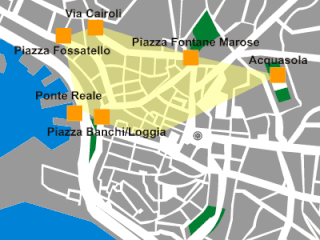
Maddalena is a neighbourhood in the old town of the Italian city of Genoa. It was one of the six sestieri of ancient Genoa. At present it is part of the Genoa's city Municipio I.
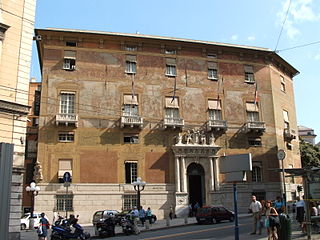
The Palazzo Doria-Spinola or Palazzo Antonio Doria is a palace located in largo Eros Lanfranco in the historical center of Genoa, Northwestern Italy. The palace was one of the 163 Palazzi dei Rolli of Genoa, one of those selected private residences where notable guests of the Republic of Genoa were hosted during State visits. On 13 luglio del 2006 it was added to the list of 42 palaces which now form the UNESCO World Heritage Site Genoa: Le Strade Nuove and the system of the Palazzi dei Rolli. The palace now hosts the Prefecture of Genoa and the seat of the Province of Genoa. It is possible to visit the areas of the building which are open to the public.
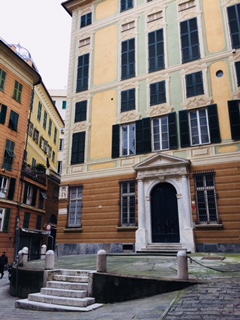
The Palazzo Clemente della Rovere is a palace located in Piazza Rovere in the historical center of Genoa, Northwestern Italy. The palace was one of the 163 Palazzi dei Rolli of Genoa, the selected private residences where the notable guests of the Republic of Genoa were hosted during State visits. On 13 luglio 2006 it was added to the list of 42 palaces which now form the UNESCO World Heritage Site Genoa: Le Strade Nuove and the system of the Palazzi dei Rolli. The palace hosts today the General Consulate of Iceland.

The palazzo Paolo Battista e Niccolò Interiano or palazzo Interiano Pallavicino is a building located in Piazza delle Fontane Marose at number 2 in Genoa, included on 13 July 2006 in the list of the 42 palaces inscribed in the Rolli di Genova that have become World Heritage by UNESCO.
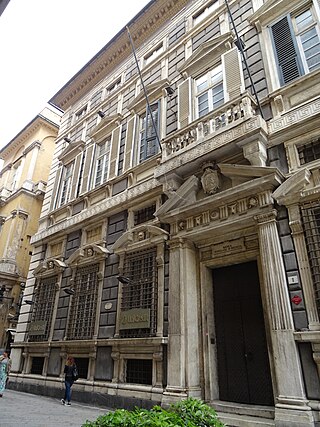
The palazzo Pallavicini-Cambiaso or palazzo Agostino Pallavicini is a building located in via Garibaldi at number 1 in the historical centre of Genoa, included on 13 July 2006 in the list of the 42 palaces inscribed in the Rolli di Genova that became World Heritage by UNESCO on that date.

The palazzo Pantaleo Spinola or palazzo Gambaro is a building located in via Garibaldi (Genoa) at number 2 in the historical centre of Genoa, included on 13 July 2006 in the list of the 42 palaces inscribed in the Rolli di Genova that became World Heritage by UNESCO on that date. The building is now the headquarters of the Banco di Chiavari e della Riviera Ligure.

The palazzo Baldassarre Lomellini also known as palazzo di Cristoforo Spinola or palazzo Campanella is a building located in via Garibaldi at number 12 in the historical centre of Genoa, included on 13 July 2006 in the list of the 42 palaces inscribed in the Rolli di Genova that became World Heritage by UNESCO on that date.
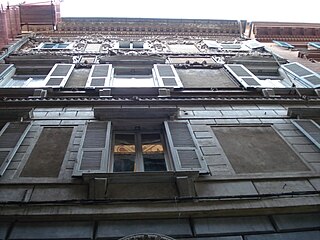
The Palazzo Tommaso Spinola, also known as Palazzo Tomaso Spinola di Luccoli or Palazzo Spinola Pessagno, is a building located in salita di Santa Caterina at number 3 in Genoa, included on 13 July 2006 in the list of the 42 palaces inscribed in the Rolli di Genova that became World Heritage by UNESCO on that date.

The Palazzo Cosma Centurione is a building located in the historical centre of Genoa, in Via Lomellini at no. 8, included on 13 July 2006 in the list of the 42 palaces inscribed in the Rolli di Genova that became World Heritage by UNESCO on that date. Also known as the Palazzo Durazzo Pallavicini or Palazzo di Gerolamo III Pallavicino, from the name of its successive owners, due to its architecture and the frescoes preserved inside, it is an outstanding example of Genoese Baroque.

The Palazzo Gio Battista Grimaldi is a building located in Piazza San Luca at number 2 in the historical centre of Genoa, included on 13 July 2006 in the list of the 42 palaces inscribed in the Rolli di Genova that became World Heritage by UNESCO on that date. The Church of San Luca (Genoa) is located in the same square.

The Palazzo Gerolamo Grimaldi also known as the palazzo della Meridiana is a building located in the salita di San Francesco at number 4 in the historical centre of Genoa, included on 13 July 2006 in the list of the forty-two palaces inscribed in the Rolli di Genova that became World Heritage by UNESCO on that date.

The Palazzo Giacomo Lomellini, also known as the Palazzo Patrone, is a building located in Largo Zecca at number 2 in Genoa, included on 13 July 2006 in the list of the 42 palaces inscribed in the Rolli di Genova that became World Heritage by UNESCO on that date.

The palazzo Belimbau, also known as palazzo Antoniotto Cattaneo or Palazzo Francesco De Ferrari, is a building located in Piazza della Nunziata at number 2 in Genoa, included on 13 July 2006 in the list of the 42 palaces inscribed in the Rolli di Genova that became World Heritage by UNESCO on that date.
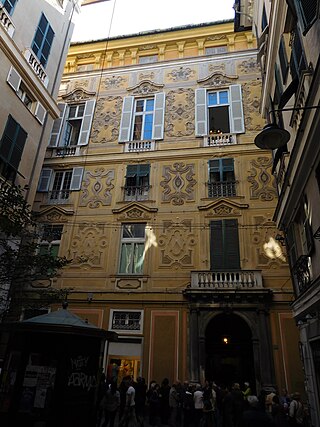
The Palazzo Nicolò Spinola di Luccoli, also called Palazzo del Marchese Stefano Franzone, or Palazzo Spinola Franzone, is a building located in Via Luccoli at number 23, in the area of the Soziglia Market in the historic centre of Genoa. The building was included in the list of palaces inscribed in the Rolli di Genova. The architecture, the decoration of the façade and the frescoes by Domenico Parodi in some of the interior rooms make it a relevant example of Genoese Baroque.
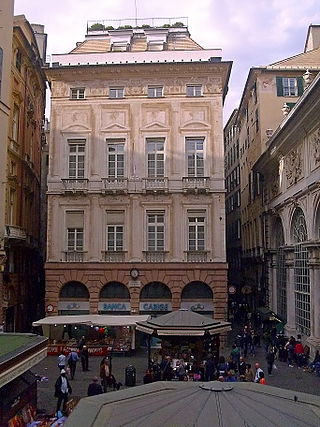
The Palazzo Ambrogio Di Negro is a building located in Via San Luca at number 2 in the area of the Mercato di Banchi in the historic centre of Genoa, included on 13 July 2006 in the list of the 42 palaces enrolled in the Rolli di Genova that became World Heritage by UNESCO on that date. It preserves an important Mannerist painting cycle inside. In front of the palace is the Loggia dei Mercanti (Genoa) and the Church of San Pietro in Banchi.

The Villa del Principe, Palazzo del Principe, or Palace of Andrea Doria in Fassolo is one of the main historical suburban villas of Genoa, Italy. It was built in the 16th century in an area that it is now located in the city center, but at the time of the construction of the villa was just outside of the city walls towards Capo di Faro and the Lanterna.




























